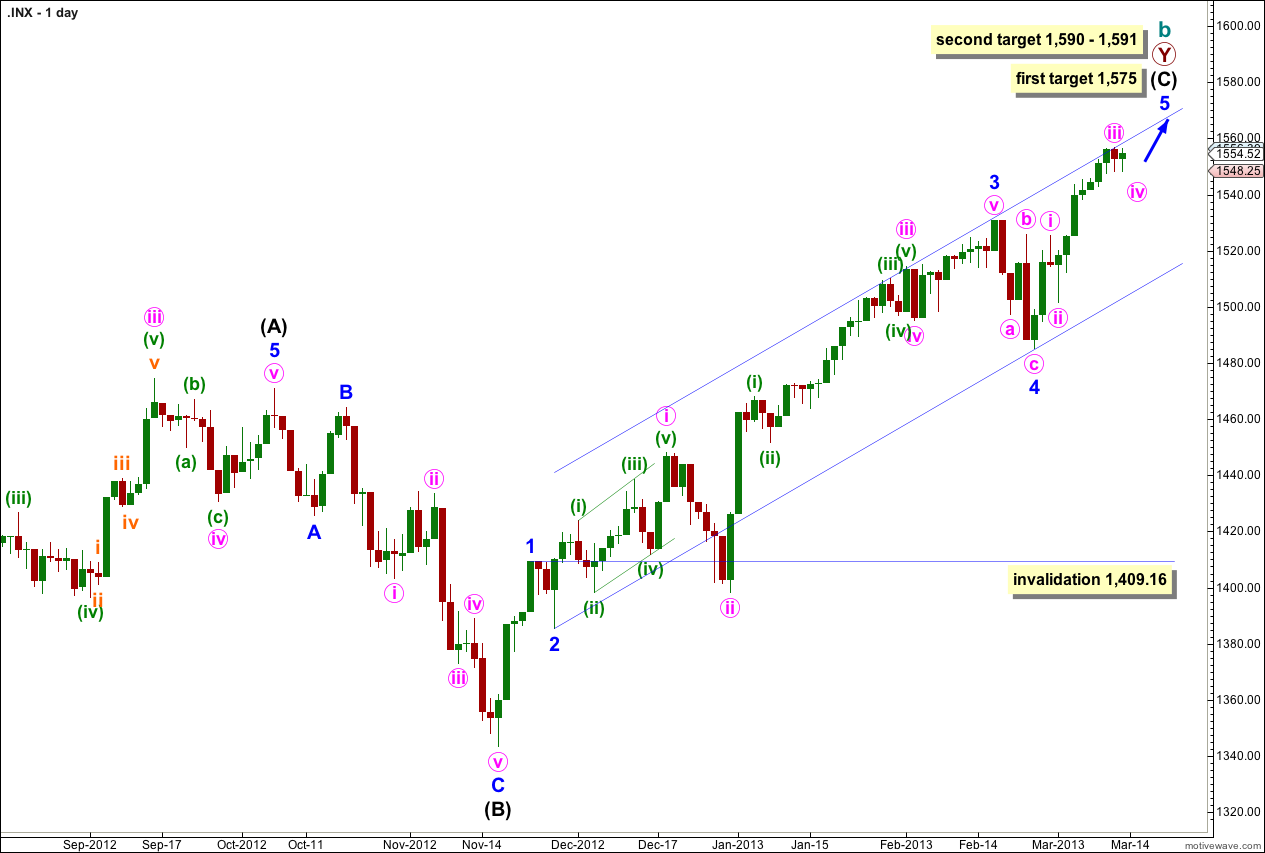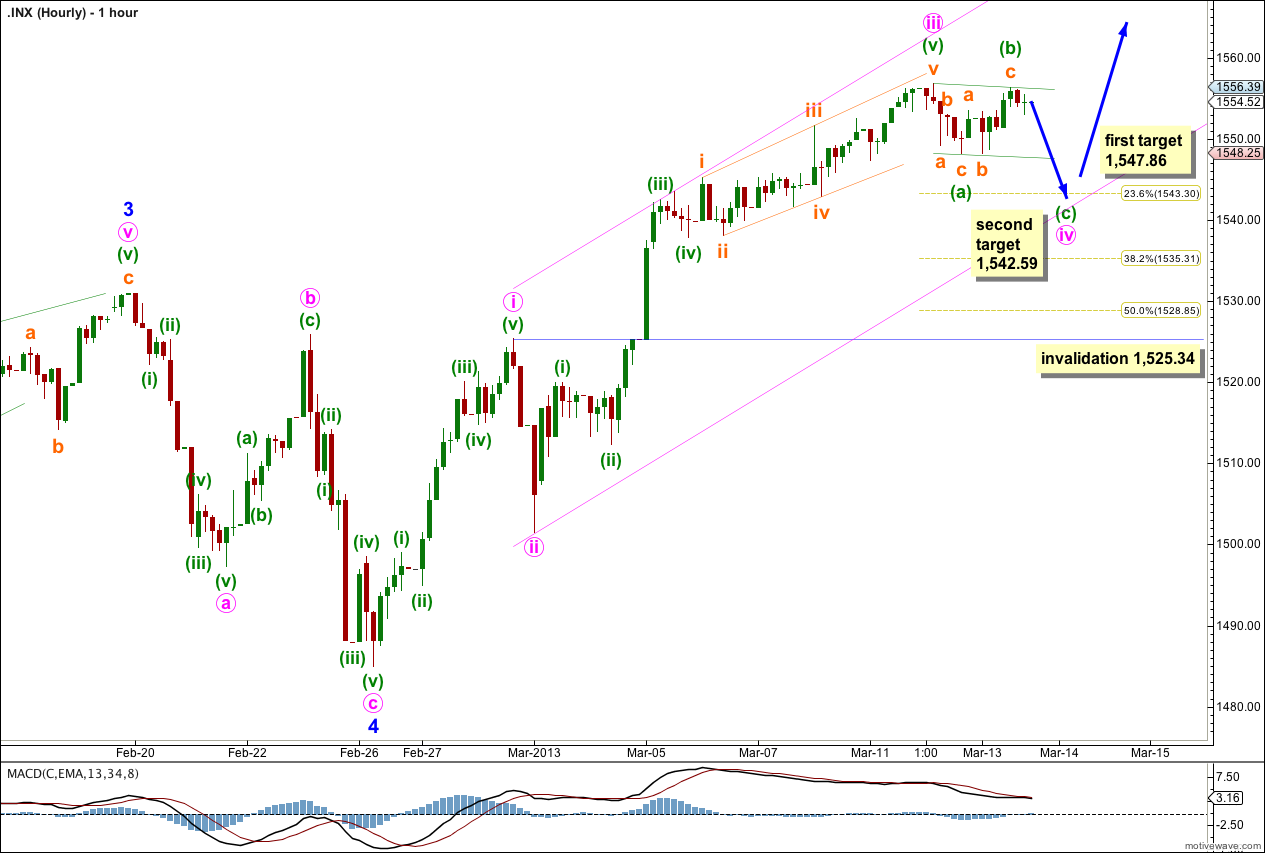Yesterday’s analysis expected upwards movement for Wednesday’s session to reach at least to 1,555.92 and unlikely to reach above 1,560. Upwards movement has reached up to 1,556.39 as expected.
The structure for this fourth wave correction is unfolding as expected and looks typical on the hourly chart. I can now calculate more accurate targets for it to end and we may now draw a channel about it.
Click on the charts below to enlarge.
The structure is within the second zigzag of a double labeled primary wave Y. Within this second zigzag intermediate wave (C) is most likely incomplete.
Within intermediate wave (C) minor waves 1 through to 4 are most likely complete. We may use Elliott’s channeling technique to draw a channel about the impulse of intermediate wave (C). Draw the first trend line from the lows of minor waves 2 to 4, then place a parallel copy upon the high of minor wave 3. At this stage it looks like minor wave 5 may end about the upper edge of this channel.
At 1,573 cycle wave b would reach 105% the length of cycle wave a. This is the minimum requirement for a B wave in relation to an A wave within an expanded flat, and as expanded flats are the most common type of flat this price point has a good probability of being reached.
At 1,575 minor wave 5 would reach 0.618 the length of minor wave 3.
If price continues to move higher through the first target then we should expect the next likely target to be at 1,590 where intermediate wave (C) would reach 0.618 the length of intermediate wave (A), and at 1,591 minor wave 5 would reach 1.618 the length of minor wave 1.
Within intermediate wave (C) minor wave 4 may not move into minor wave 1 price territory. This wave count is invalidated with movement below 1,409.16.
Within intermediate wave (C) minor wave 1 has no Fibonacci duration lasting 4 days, minor wave 2 lasted a Fibonacci 3 days, minor wave 3 lasted a Fibonacci 55 days, and minor wave 4 lasted a Fibonacci 5 days. So far minor wave 5 has lasted 11 days and is incomplete. A possible end may be at a Fibonacci 21 days which will be in another 10 sessions. If it does not end there then a further 13 sessions would take it to a Fibonacci 34. At each Fibonacci time duration I will look at the structure to see if it could be complete and if so we shall have an alternate wave count for that possibility.
At intermediate degree wave (C) has so far lasted 78 sessions. In another 11 sessions it will have lasted a Fibonacci 89.
The most likely end to this trend may be 28th March, 2013 (give or take one day either side). However, Fibonacci time relationships are not always reliable. This is a guideline only.
Upwards movement for minuette wave (b) subdivides nicely into a three wave structure, itself a regular flat correction. Within minuette wave (b) subminuette wave b is a 104% correction of subminuette wave a, and sumbminuette wave c is just 0.09 short of 1.618 the length of subminuette wave a.
Within minuette wave a zigzag there is no Fibonacci ratio between subminuette waves a and c.
Minuette wave (b) is a 95.5% correction of minuette wave (a) so minute wave iv looks like a regular flat correction. The most common length for minuette wave (c) would be equality with minuette wave (a) at 1,547.86.
If price continues through this first target then the next target is at 1,542.59 where minuette wave (c) would reach 1.618 the length of minuette wave (a) and price would reach to just below the 0.236 Fibonacci ratio of minute wave iii at 1,543.3.
Regular flat corrections often (not always) fit well within parallel channels. Draw the first trend line from the start of minuette wave (a) to the end of minuette wave (b) then place a parallel copy upon the end of minuette wave (a). Price may find support about the lower end of this channel which coincides nicely with the first target.
If price breaks through support at the smaller channel containing minute wave iv then it may find another level of support about the lower edge of the wider parallel channel drawn about minor wave 3.
Minute wave iv may not move into minute wave i price territory. This wave count is invalidated with movement below 1,525.34.



Thanks … I will look for your update
Ending Diagonal?? 1565
No. It subdivides as an impulse.